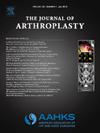用于全关节成形术的 2-辛基-氰基丙烯酸酯网状敷料:敷料设计影响伤口并发症的风险。
IF 3.4
2区 医学
Q1 ORTHOPEDICS
引用次数: 0
摘要
简介:最近,在全关节置换术(TJA)中,使用网状补片和 2-辛基氰基丙烯酸酯液体配方的液体皮肤粘合剂闭合系统显示出良好的效果。化学促进剂通常用于促进 2-辛基氰基丙烯酸酯的快速聚合。本研究的目的是区分两种类似系统在设计和伤口并发症方面的差异:从 2023 年 7 月到 12 月,我们进行了一项为期 18 周的回顾性研究,研究对象包括一家医疗机构四位主治外科医生的 207 例全髋关节置换术 (THA) 和 212 例全膝关节置换术 (TKA),研究对象使用了两种敷料设计中的一种。两种敷料都采用 2-辛基氰基丙烯酸酯液体粘合剂配方,局部涂抹在覆盖伤口的聚酯网片上。网状敷料 A(用于 274 例)在网状贴片上添加了一种季铵盐促进剂,而网状敷料 B(用于 145 例)在粘合剂涂抹器中添加了类似的促进剂:接受网片 A 和网片 B 治疗的患者的伤口并发症(3.2% 对 7.6%;X2 = 3.86;df = 1;P = 0.049)、早期假体周围关节感染 (PJI) (0 对 2.8%;X2 = 7.63;df = 1;P = 0.006)和 90 天伤口并发症再手术率(0.4% 对 3.4%;X2 = 6.39;df = 1;P = 0.011)分别显著降低。在浅表手术部位感染(SSI)(0.7 对 0%;X2 = 1.06;df = 1;P = 0.302)或过敏率(3.3 对 4.1%;X2 = 0.12;df = 1;P = 0.655)方面,网片 A 和网片 B 之间没有差异:我们观察到两种设计在伤口并发症、术后早期 PJI 和 90 天再次手术方面有明显不同。将加速器置于涂抹器中而不是网片上,可能会导致在与网片适当粘合之前过早聚合,从而产生理想的伤口闭合和密封效果。本文章由计算机程序翻译,如有差异,请以英文原文为准。
2-Octyl-Cyanoacrylate Mesh Dressings for Total Joint Arthroplasty: Dressing Design Influences Risks of Wound Complications
Background
Recent liquid adhesive skin closure systems with a mesh patch and a 2-octyl cyanoacrylate liquid formula have shown promising results in total joint arthroplasty. Chemical accelerators are typically included to promote the rapid polymerization of 2-octyl cyanoacrylate. The goal of the study is to distinguish designs and wound complication differences between 2 similar systems.
Methods
An 18-week retrospective study was conducted from July to December 2023, including 207 total hip arthroplasty and 212 total knee arthroplasty cases from 4 attending surgeons at 1 institution that used 1 of 2 dressing designs. Both dressings had a 2-octyl cyanoacrylate liquid adhesive formula that applied topically to a polyester-based mesh overlaying the wound. Mesh A (used in 274 cases) included an accelerator, a quaternary ammonium salt, on the mesh patch, whereas Mesh B (used in 145 cases) included a similar accelerator within the adhesive applicator.
Results
Wound complications (3.2 versus 7.6%; X2 = 3.86; df = 1; P = .049), early periprosthetic joint infections (0 versus 2.8%; X2 = 7.63; df = 1; P = .006), and 90-day reoperations for wound complications (0.4 versus 3.4%; X2 = 6.39; df = 1; P = .011) were significantly lower in patients who received Mesh A versus B, respectively. There was no difference in superficial surgical site infections (0.7 versus 0%; X2 = 1.06; df = 1; P = .302) or allergy rates (3.3 versus 4.1%; X2 = 0.12; df = 1; P = .655) between Mesh A and B.
Conclusions
We observed significantly different performance in wound complications, early postoperative periprosthetic joint infections, and 90-day reoperation between the 2 designs. Having the accelerator in the applicator rather than on the mesh patch may lead to premature polymerization before bonding appropriately with the mesh to create the desired wound closure and seal.
Level of Evidence
Level III.
求助全文
通过发布文献求助,成功后即可免费获取论文全文。
去求助
来源期刊

Journal of Arthroplasty
医学-整形外科
CiteScore
7.00
自引率
20.00%
发文量
734
审稿时长
48 days
期刊介绍:
The Journal of Arthroplasty brings together the clinical and scientific foundations for joint replacement. This peer-reviewed journal publishes original research and manuscripts of the highest quality from all areas relating to joint replacement or the treatment of its complications, including those dealing with clinical series and experience, prosthetic design, biomechanics, biomaterials, metallurgy, biologic response to arthroplasty materials in vivo and in vitro.
 求助内容:
求助内容: 应助结果提醒方式:
应助结果提醒方式:


